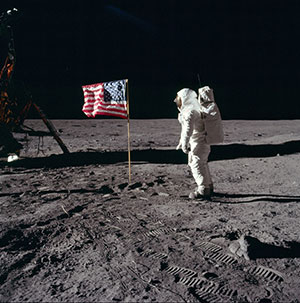
Contact Us
Institutional Communications
Bureau of Mines Building, Room 137
Laramie, WY 82071
Phone: (307) 766-2929
Email: cbaldwin@uwyo.edu
UW Planetarium to Celebrate 1969 Historic Moon Landing with Programs in July
Published June 23, 2021

Astronaut Buzz Aldrin salutes the American flag during the Apollo moon landing in
1969. The historic event will be highlighted in a program, titled “Apollo to Orion,”
Friday, July 16, at 7 p.m. in the UW Harry C. Vaughan Planetarium. (UW Planetarium
Photo)
The moon will take center stage in July, with no less than three programs focused on the subject at the University of Wyoming Harry C. Vaughan Planetarium.
“We’ll be taking a break from our schedule Independence Day weekend but resume with programs in July,” says Max Gilbraith, the planetarium’s coordinator. “I’m looking forward to our week of Apollo-themed programs -- detailing the original missions, past efforts and the upcoming Orion Program to return humans to the moon. Those who like to get lost in deep space will enjoy observing the universe in invisible wavelengths, hunting for life on Mars or diving into black holes.”
A film and special live talk for audiences will be featured each week.
To get tickets or receive more information about programs, email planetarium@uwyo.edu or leave a voicemail and a call-back phone number at (307) 766-6506. Tickets are $5 for the public and $3 for students, senior citizens, veterans, first responders and those under 18. Seating is free for children under 5.
Reservations or pre-purchase is not required, and walk-ins are welcome. Tickets can be purchased online with a credit card, reserved by email or voicemail, or purchased at the start of the show. Cash or check is accepted at the door. The planetarium, which seats 58, is located in the basement of the Physical Sciences Building. Seating is on a first-come, first-served basis outside of designated ADA/wheelchair seating.
“Capacity restrictions, masking and reservations are no longer required,” Gilbraith says. “We’ve brought back online ticket sales for those who like to pay with a credit card.”
To pay for tickets with a credit card, go to https://www.uwyo.edu/uwplanetarium/ticket.aspx.
The July schedule is as follows:
-- No public shows July 1-5.
-- “Wyoming Skies,” Tuesdays, July 6 and 20, 7 p.m. This program provides an exploration of the stars, constellations, planets and other celestial phenomena visible from Laramie for the season.
-- “NASA’s Great Observatories,” Friday, July 9, 7 p.m. Hubble, Spitzer, Chandra and Compton are great names in astronomy and great telescopes that see beyond the limited light that can pierce the atmosphere of Earth. Visitors will be able to see and learn what can only be seen of space from space.
-- Full-dome movie: “Cosmic Origins Spectrograph,” Saturday, July 10, 2 p.m. This 30-minute film highlights the current research of Cosmic Origins Spectrograph (COS) aboard the Hubble Space Telescope, the last instrument installed by NASA astronauts. COS allows an unprecedented view into the vast spaces between galaxies that surround the Milky Way. The presentation will be followed by a live lecture, a question-and-answer session and a star talk.
-- “Apollo to Orion,” Friday, July 16, 7 p.m. Fifty-two years ago, a crew of three astronauts left Earth to do what no one had ever done before. Visitors will see epic photography, video and other media from the lunar exploration of the past. They also will learn about the ongoing plans to return humans to the moon in the near future.
-- Full-dome movie: “Back to the Moon for Good,” Saturday, July 17, 2 p.m. This film opens with the first era of space exploration in the late 1960s and early 1970s. Viewers will learn what that era of landers and orbiters taught about the moon, including the discovery of its origin, composition, structure and the accessibility of raw materials on its surface.
-- “Black Holes,” Friday, July 23, 7 p.m. Are black holes nature’s mistake or portals to the unknown? Physics allows people to speculate about the nature of these bizarre structures, but astronomers are taking a closer look at these mysterious and fascinating objects.
-- Full-dome movie: “Max Goes to the Moon,” Saturday, July 24, 2 p.m. Max, a dog, and a young girl named Tori take the first trip to the moon since the Apollo era. Along the way, the story sets the stage for the more sophisticated science of the “Big Kid Box” sidebars, which cover topics including “Phases of the Moon,” “Wings in Space?” and “Frisbees and Curve Balls on the Moon” -- all explained so that adults and children can learn together about science.
-- “Mars,” Friday, July 30, 7 p.m. The Red Planet is host to many questions: Did it used to be like Earth? Did it once harbor life? Could it still support life today? And, is it a future home for humans? Landers, rovers, probes and satellites have returned data for decades, and there are more clues every day.
-- Full-dome movie: “Two Small Pieces of Glass,” Saturday, July 31, 2 p.m. This show follows two students as they interact with a female astronomer at a local star party. Along the way, the students learn the history of the telescope from Galileo’s modifications to a child’s spyglass -- using two small pieces of glass -- to the launch of the NASA/European Space Agency Hubble Space Telescope and the future of astronomy. This show explores the wonder and discovery made by astronomers throughout the last 400 years.
All programs are about an hour in length. As time allows, a portion of the show also may focus on a live sky tour or supporting information related to the film’s topic.
If you have a group larger than six, it is recommended to contact the planetarium for a private show at https://uwyo.sjc1.qualtrics.com/jfe/form/SV_bKuqIynOn7gFK2F, Gilbraith says. The rate for private shows is the same as ticket prices for public shows, he says.
Contact Us
Institutional Communications
Bureau of Mines Building, Room 137
Laramie, WY 82071
Phone: (307) 766-2929
Email: cbaldwin@uwyo.edu
